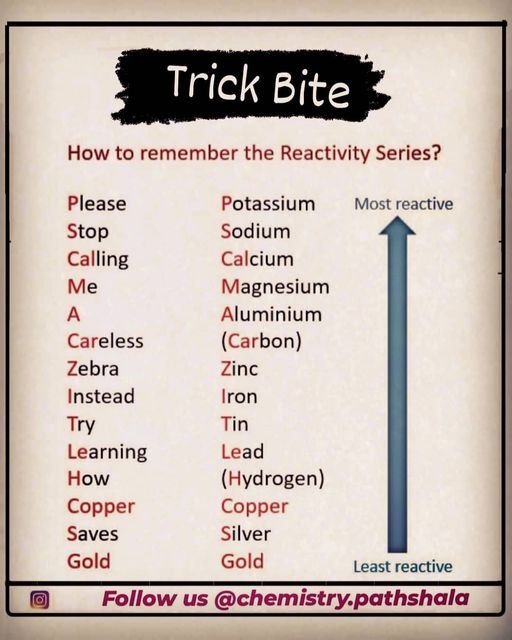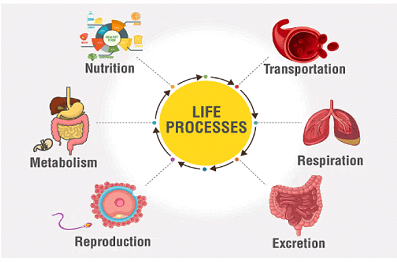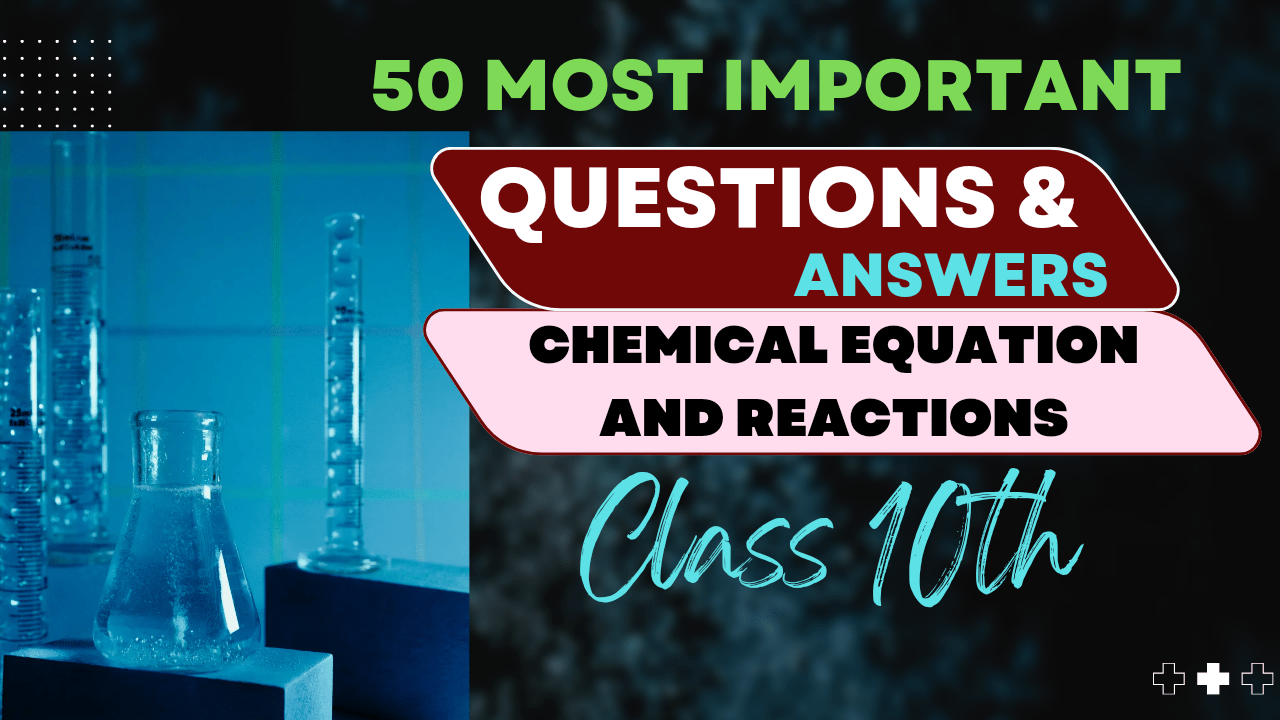Reactivity Series of Metals
Understanding the Order of Metal Reactivity and Its Applications
Introduction to the Reactivity Series
The reactivity series is a fundamental concept in chemistry that ranks metals according to their chemical reactivity. This series helps predict how vigorously metals react with water, acids, and oxygen, making it essential for understanding various chemical processes and reactions.
Definition: The reactivity series is an arrangement of metals in decreasing order of their reactivity based on their tendency to lose electrons and form positive ions (cations) during chemical reactions.
The Complete Reactivity Series

Fig 1: The reactivity series of metals arranged from most reactive (top) to least reactive (bottom)
The reactivity series, from most reactive to least reactive, is as follows:
| Position | Metal | Symbol | Reactivity Level | Reaction with Water |
|---|---|---|---|---|
| 1 | Potassium | K | Extremely high | Violent reaction with cold water |
| 2 | Sodium | Na | Very high | Violent reaction with cold water |
| 3 | Lithium | Li | High | Rapid reaction with cold water |
| 4 | Calcium | Ca | High | Moderate reaction with cold water |
| 5 | Magnesium | Mg | Medium-high | Reacts slowly with cold water, rapidly with hot water |
| 6 | Aluminum | Al | Medium | Reacts with steam, not with cold water |
| 7 | Zinc | Zn | Medium | Reacts with steam, not with cold water |
| 8 | Iron | Fe | Medium-low | Reacts slowly with steam, not with cold water |
| 9 | Lead | Pb | Low | Does not react with water or steam |
| 10 | Copper | Cu | Very low | Does not react with water or steam |
| 11 | Silver | Ag | Extremely low | Does not react with water or steam |
| 12 | Gold | Au | Practically inert | Does not react with water or steam |
| 13 | Platinum | Pt | Practically inert | Does not react with water or steam |
Remember: “Please Send Lions Cats Monkeys And Zebras Into Fields, Lead Can Silver And Gold Plainly.” – A mnemonic to help remember the order (Potassium, Sodium, Lithium, Calcium, Magnesium, Aluminum, Zinc, Iron, Lead, Copper, Silver, Gold, Platinum).
Relationship Between Reactivity and Reactions
1. Reaction with Water
The reactivity of a metal determines how it reacts with water:
- K, Na, Li, Ca – React with cold water to produce metal hydroxide and hydrogen gas
- Mg – Reacts slowly with cold water but more rapidly with hot water
- Al, Zn, Fe – React with steam (not cold water) to form metal oxide and hydrogen
- Pb, Cu, Ag, Au, Pt – Do not react with water in any form
2. Reaction with Acids
Reactivity also determines how metals react with acids:
- Metals above hydrogen in the series react with dilute acids to produce a salt and hydrogen gas
- The more reactive the metal, the more vigorous the reaction
- Metals below hydrogen (Cu, Ag, Au, Pt) do not normally react with dilute acids to produce hydrogen
3. Reaction with Oxygen (Oxidation)
Metals combine with oxygen to form metal oxides:
- More reactive metals (K, Na, Ca, Mg) oxidize rapidly, sometimes violently when heated
- Some reactive metals like K and Na must be stored under oil to prevent oxidation
- Aluminum forms a protective oxide layer that prevents further oxidation
- Less reactive metals like Cu, Ag, and Au oxidize very slowly or not at all
4. Displacement Reactions
A more reactive metal can displace a less reactive metal from its compound (usually from its salt solution):
Example: When zinc is placed in copper sulfate solution, zinc displaces copper:
This happens because zinc is more reactive than copper and can donate electrons more readily.
Key concept: A metal can only displace metals below it in the reactivity series from their compounds.
Practical Applications
1. Extracting Metals
The reactivity series determines the method used to extract metals from their ores:
- Highly reactive metals (K to Al) – Extracted by electrolysis
- Moderately reactive metals (Zn, Fe) – Extracted by reduction with carbon
- Less reactive metals (Cu to Au) – Found in native state or extracted by simple heat
2. Galvanization
Iron is coated with zinc (galvanized) to prevent corrosion. Since zinc is more reactive than iron, it corrodes preferentially, protecting the iron underneath. This is called sacrificial protection.
3. Metal Displacement in Industry
The principle of metal displacement is used in various industrial processes, including the extraction of copper from copper sulfate solutions using scrap iron.
Simple Experiment: Metal Displacement
Materials: Copper sulfate solution, zinc strip, iron nail, magnesium ribbon, test tubes
Procedure:
- Place equal amounts of copper sulfate solution in three test tubes
- Place zinc strip in the first tube, iron nail in the second, and magnesium ribbon in the third
- Observe the changes after 10-15 minutes
Observations: All three metals will displace copper (reddish-brown deposit), but at different rates. Magnesium (most reactive) will cause displacement fastest, followed by zinc, then iron.
Factors Affecting Reactivity
Several factors determine a metal’s position in the reactivity series:
1. Atomic Structure
The key factor is the ease with which a metal atom can lose electrons to form positive ions. This depends on:
- Number of valence electrons – Metals with fewer valence electrons tend to be more reactive
- Atomic size – Larger atoms have valence electrons farther from the nucleus, making them easier to lose
- Nuclear charge – Lower effective nuclear charge means weaker attraction for electrons
2. Ionization Energy
Ionization energy is the energy required to remove an electron from an atom:
- Lower ionization energy = easier to lose electrons = higher reactivity
- Metals at the top of the reactivity series (K, Na, Ca) have low ionization energies
- Metals at the bottom (Cu, Ag, Au) have high ionization energies
3. Electrode Potential
The standard electrode potential (E°) of a metal is another measure of its reactivity:
- More negative electrode potential = more reactive metal
- Potassium has E° = -2.92V (highly reactive)
- Gold has E° = +1.42V (very unreactive)
Key Points for Exam Preparation
- Order of the series: Learn the complete order of metals in the reactivity series, possibly using a mnemonic.
- Reactivity patterns: Understand how reactivity decreases as you go down the series.
- Water reactions: Remember which metals react with cold water, hot water, steam, or not at all.
- Displacement reactions: A more reactive metal will always displace a less reactive metal from its compounds.
- Extraction methods: Connect the position in the reactivity series to the appropriate extraction method.
- Application knowledge: Know practical applications like galvanization and extraction processes.
- Explain exceptions: Be prepared to explain why aluminum appears less reactive than expected (protective oxide layer).
- Hydrogen position: Understand that hydrogen is often included in the series (between lead and copper).
Common Exam Mistakes:
- Mixing up the order of metals in the series
- Incorrectly predicting whether a displacement reaction will occur
- Forgetting that aluminum forms a protective oxide layer (appears less reactive than it actually is)
- Not being able to write balanced equations for reactions
Practice Questions
1. Predict whether the following reactions will occur. Explain your reasoning.
a) Magnesium + Copper sulfate solution
b) Silver + Zinc nitrate solution
c) Iron + Lead nitrate solution
d) Copper + Iron sulfate solution
2. Arrange the following metals in order of increasing reactivity: Gold, Aluminum, Copper, Potassium, Iron
3. Explain why:
a) Sodium must be stored under oil
b) Copper is used for water pipes but not sodium
c) Iron rusts faster than aluminum even though aluminum is more reactive




